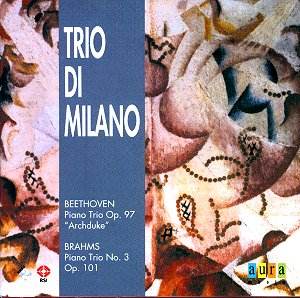The Trio di Milano was founded in 1968 by violinist
Cesare Ferraresi, cellist Rocco Filippini and pianist Bruno Canino.
Ferraresi was the elder statesman, born in 1919 and scion of a famous
musical family, his brother Aldo being one of Italy’s leading violinists
and around whom something of a mini-cult has now developed. Canino was
born in 1936 and has an international career and Filippini has made
a number of admired discs whilst Ferraresi died too young in 1981, his
place being taken in the trio by the leader of I Musici, the Rumanian
born Mariana Sirbu. The Trio di Milano took their place immediately
in the firmament of existing Italian trios – competition existed in
the shape of the trios of Trieste and Bologna – but they have remained
durable and flexible exponents of the repertoire.
Cesare Ferraresi was a one-time leader of the RAI Orchestra
as well as a teacher and chamber player of note; he and his brother
were apparently good tango players as well, a skill Cesare exploited
publicly in his cash-starved days. The Trio di Milano here essay two
staples of the trio literature in performances dating from 1971 and
1978. Their Archduke is not unconscionably slow, but it is still
relaxed in the modern manner – a post-Casals performance as it were.
There is a deal of neat and unaffected phrasing from all three players
– indeed unaffected is the adjective I would most apply to their playing
in general – and in the first movement they follow the dynamic curve
and cantilever of the music with skill and sensitivity. No over emoting
hinders the passagework; the two string players are clean limbed and
even of scale and Canino a supportive and indeed active ingredient in
the ensemble, prompting and often leading through rich voicings. They
bring to the slow movement an unostentatious affection but are also
alive to the faster section’s opportunities for sharp articulation;
some quick détaché bowing animates the line here. Occasionally
Ferraresi comes under a little tonal pressure and the recording, which
is not opulent, imparts a degree of shrillness to his tone. In the finale
some of the string entry points sound a little tentative and there’s
a jerky, not entirely convincing air to the proceedings, which rather
disappoints. In the Brahms they are more comprehensively successful;
strong but not oversized, with a good tonal confluence and a sense of
appropriate dynamics they are sound guides to the trio. A few minor
intonational slips in the whizzing Presto are of very little account
and this is well scaled and musicianly playing all round.
The notes by Piero Rattalino are affectionate about
Ferraresi, whom he knew and with whom he worked, and if this pitches
the CD as rather more his memorial than the trio’s that’s not necessarily
a bad thing. Cesare Ferraresi was a good musician and his trio served
music honestly and well.
Jonathan Woolf


